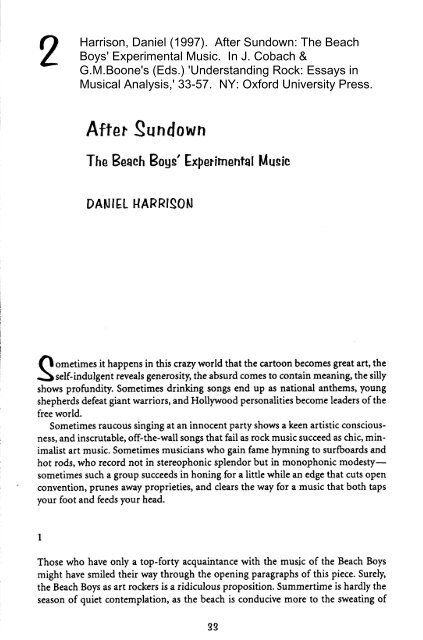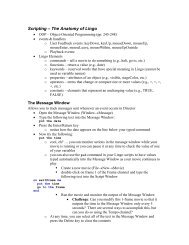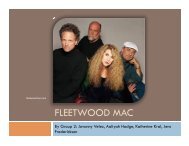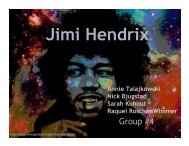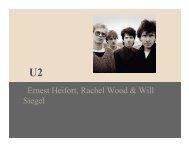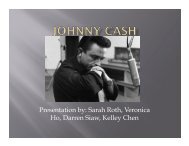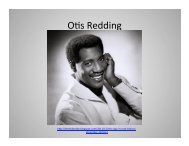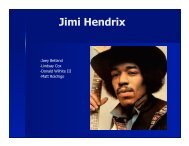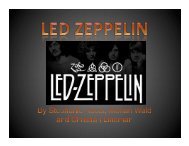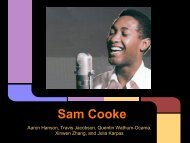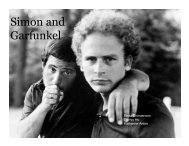After Sundown: The Beach Boys' Experimental ... - Scott D. Lipscomb
After Sundown: The Beach Boys' Experimental ... - Scott D. Lipscomb
After Sundown: The Beach Boys' Experimental ... - Scott D. Lipscomb
Create successful ePaper yourself
Turn your PDF publications into a flip-book with our unique Google optimized e-Paper software.
2<strong>After</strong> <strong>Sundown</strong><strong>The</strong> <strong>Beach</strong> <strong>Boys'</strong> <strong>Experimental</strong> MusicDANIEL HARRISONSometimes it happens in this crazy world that the cartoon becomes great art, theself-indulgent reveals generosity, the absurd comes to contain meaning, the sillyshows profundity. Sometimes drinking songs end up as national anthems, youngshepherds defeat giant warriors, and Hollywood personalities become leaders of thefree world.Sometimes raucous singing at an innocent party shows a keen artistic consciousness,and inscrutable, off-the-wall songs that fail as rock music succeed as chic, minimalistart music. Sometimes musicians who gain fame hymning to surfboards andhot rods, who record not in stereophonic splendor but in monophonic modestysometimessuch a group succeeds in honing for a little while an edge that cuts openconvention, prunes away proprieties, and clears the way for a music that both tapsyour foot and feeds your head.1Those who have only a top-forty acquaintance with the music of the <strong>Beach</strong> Boysmight have smiled their way through the opening paragraphs of this piece. Surely,the <strong>Beach</strong> Boys as art rockers is a ridiculous proposition. Summertime is hardly theseason of quiet contemplation, as the beach is conducive more to the sweating of33
34 Understanding Rock <strong>After</strong> sundown 35erotic perfumes than to the cool meeting of minds. But one famous top-forty <strong>Beach</strong>Boys hit ought to give the reader pause: “Good Vibrations,,’ widely acknowledged asone of rock music’s greatest masterpieces, can hardly be dismissed as mindlessbeach fare. Indeed, its prominent images are not surf ’n’ sun but sensory stimuli ofnear psychedelic intensity; the atmosphere is one not of roaring fun, but of deep yetseemingly improvised introspection. “Good Vibrations” clearly expresses another,far different sensibility from that of the <strong>Beach</strong> Boys’ better-known top-forty hits. Itis both so exotically different and yet recognizably within the <strong>Beach</strong> Boys’ style thatone cannot help but wonder about the existence of other like-minded works. Whatelse happened when the surfboards were put up for the night?Even from their inception the <strong>Beach</strong> Boys were an experimental group. <strong>The</strong>ycombined, as Jim Miller has put it, “the instrumental sleekness of the Ventures,the lyric sophistication of Chuck Berry, and the vocal expertise of some weird crossbetween the Lettermen and Frankie Lymon and the Teenagers” with lyrics whoseimages, idioms, and concerns were drawn from the rarefied world of the middleclasswhite male southern California teenager.’ This choice of subject was itself ahighly experimental act; instead of exploring typical adolescent topics as generallyas possible-an artistic and marketing strategy that targets a wide audience-the<strong>Beach</strong> Boys refracted them through a very specific and, indeed, esoteric worldview.Full of the specialized slang of surfers and street racers, localized geographic and climaticreferences, and obsession with good times and fun, <strong>Beach</strong> Boys’ songs provedhighly attractive to teenagers across the world despite their apparent esotericism;being in on the ways of an elite and hip subculture as well as its thickly texturedhedonism turned out to be a powerful engine for promoting escapism, fantasy, andfrolic-prized commodities for any teenager.While the unusual and, for a while, interesting combination of elements madethe <strong>Beach</strong> Boys almost single-handedly responsible for a national surf-music fad inthe early 1960s,2 it was the profound vocal virtuosity of the group, coupled with theobsessional drive and compositional ambitions of their leader, Brian Wilson, thatpromised their survival after the eventual breaking of fad fever. On the first point,the original group of three brothers, a cousin, and a neighbor possessed a rare andwonderful vocal tightness. Comparison to other contemporary vocally orientedrock groups, such as the Association, shows the <strong>Beach</strong> Boys’ technique to be farsuperior, almost embarrassingly so. <strong>The</strong>y were so confident of their ability, and ofBrian’s skill as a producer to enhance it, that they were unafraid of doing sophisticated,a cappella glee-club arrangements containing multiple suspensions, passingformations, complex chords, and both chromatic and enharmonic modulations.3Some of these techniques are shown in example 2.1, an excerpt from Brian’sarrangement of a Four Freshmen hit, “<strong>The</strong>ir Hearts Were Full of Spring.”<strong>The</strong> examplegives the wispiest taste of the technical ability the <strong>Beach</strong> Boys had at their disposal;unable to be captured in the score is the sensitivity to blend and intonationthat enabled the group to undertake such arrangements, as well as Brian’s expertrecording technique.4Clearly, “Hearts” is not rock ’n’ roll, so citing it can seem a bit disingenuous. Yetthe point here is not that the <strong>Beach</strong> Boys made rock ’n’ roll out of glee-club mater-Example 2.1. Bobby Troup: “<strong>The</strong>ir Hearts Were Full of Spring,” arr. B. Wilson, mm.1-8ial, but that the harmonic resources and the compositional sophistication of thatrepertory (relative to the rock ’n’ roll of the early 1960s) were available to them, andthat they could bring these to their original works.<strong>The</strong> easiest point of transfer for these sophisticated techniques was the ballad,generally identifiable by slow tempo in compound duple meter. <strong>The</strong> <strong>Beach</strong> Boysadded their own stylistic signature to this common genre: a falsetto lead melodyover both an unobtrusive instrumental accompaniment and a thick choral texture.“Surfer Girl,”“In My Room,” and “Warmth of the Sun” are perhaps the best-knownexemplars of the <strong>Beach</strong> Boys’ ballad style, and in each of these one finds at least oneharmonic or formal twist not native to rock ’n’ roll. Example 2.2, for instance, whichillustrates the harmonic and rhythmic structure of “Warmth of the Sun,” shows aself-consciously intrepid root motion by tritone from vi to bIII. <strong>The</strong> problems incarrying off such a remote chord change are mitigated by the larger-scale modalmixture. As the analysis shows, the tritone motion marks the entry point of minormode; major returns subtly upon the entrance of ii7 and more firmly upon the resolutionof the augmented-minor seventh chord at the end of the first ending. Later inthe song, VI is revisited-this time as a key-and again participates in modal mixture;the refrain begins upon a tonicized VI# (A major) and then slips into its naturalversion before progressing to G major as V of C. Needless to say, the voice leadingcarrying out these chord changes is clean and classically correct.“Warmth of the Sun,” as well as the other ballads, shows its stylistic and genreorigins most clearly. But even the least distinguished of the <strong>Beach</strong> Boys’ early uptemporock ‘n’ roll songs show traces of structural complexity at some level; Brianwas simply too curious and experimental to leave convention alone. Consider in thisregard example 2.3, which shows the harmonic structure of an otherwise ephemeral
36 Understanding Rock <strong>After</strong> <strong>Sundown</strong> 37c: I7 7iii575I7i 9-8-7G: ii IExample 2.2. “Warmth of the Sun,” comp. B. Wilson. Harmonic analysissurf-music work, “Don’t Back Down.” Of interest here is obviously not the harmonicstructure of the individual structural components, which is quite conventional,but the large-scale modulatory plan that takes the A-major verses into Bbmajorrefrains and back again. Though half-step key relationships are common inrock ’n’ roll-they afford a dramatic and expressive use of tonality, as well as a min-imal change in range for the vocally untrained lead singer-the manner in whichthe <strong>Beach</strong> Boys carried out this key change is quite complex. <strong>The</strong> analysis shows achromatic modulation that depends upon modal mixture: an F-major chord as bVIof A major pivots to become V of Bb, a shift marked with an asterisk in the example.<strong>The</strong> dramatic effect of the F-major pivot chord is strengthened by its unexpectedshortness: it lasts only a measure, while previous harmonies filled out at least twomeasures. <strong>The</strong> new Bb tonic thus rushes in a full measure sooner than expectedbased on the preceding hypermetrical structure of the verse. <strong>The</strong> return to A majoris handled in a different, though equally interesting way. Example 2.4 shows a tran-scription of the last three measures of the refrain, which then connect to the openingof the verse. <strong>The</strong> refusal of I in favor of in measure 2 is followed by a passingA: IBb: I vExample 2.3. “Don’t Back Down:’ comp. B. Wilson. Harmonic analysis83xIiExample 2.4. “Don’t Back Down,” transcription of mm. 5-8 of refrainmotion that reaches a major-minor seventh over C in measure 3. (Temptingly analyzableas of V in Bb, it is rather a passing chord whose ultimate goal is-orrather should be-I in Bb.) Yet this unstable chord serves as the tentative conclusionof the refrain. <strong>The</strong> E appearing on the fourth beat, far from harmonizing nicely withthe C-major-minor seventh, introduces itself as in A, thus effecting a commontonemodulation back to A. Again, as in the movement into Bb, a rhythmic irregularityhighlights the modulation; in this case, odd-even measure alternation of oneand two harmonies per bar (clearly seen in ex. 2.3) is broken, so that measure 2 ofthe example (which is the seventh measure of the refrain) receives two harmonies,the following measure, only 0ne.5he <strong>Beach</strong> Boys’ initial commercial success gave Brian the prestige, resources,T and courage to carry out further stylistic experiments. <strong>The</strong> motivation for theseis complex. Certainly much must be attributed to Brian’s innate musical curiosity.But also at work here is the inherent stylistic constriction that created such narrowgenres as “surf” and “hot-rod” music. If they were to be anything more than a musicalnine-days’-wonder, the <strong>Beach</strong> Boys had to find ways to broaden the range oftheir lyrics, the structure of their songs, and the texture of their vocal and instrumentalsounds.6Glimmerings of change can be heard in the two 1965 albums, <strong>The</strong> <strong>Beach</strong> BuysToday! and Summer Days (and Summer Nights!!).7 <strong>The</strong> ballads and slower numberscontain more complex lyrical expressions than before, treating such “un-fun” topicsas the loss of youthful innocence (“When I Grow Up”) and emotional vulnerability(“She Knows Me Too Well”). But harmonic and formal innovations in these songsare just as notable. In light of subsequent developments, one of the most interestingtechnical experiments involves quick-changing, unpredictable, yet logical harmonicrelationships to access remote keys, thereby giving an illusion of a formal expanselarger than the eight or so measures that actually contain it. <strong>The</strong> most famous exampleis the refrain of “California Girls,” transcribed in example 2.5. Although onpaper it is easy enough to see that the structure is “logically” governed by a descendingsequence, the effect in sound of this sequence is quite remarkable, largelybecause arrivals at the third and fifth measures are so extraordinarily striking andaffecting. In fact, these moments are so arresting, so harmonically unusual, so unexpectedlyexpansive, that one is drawn away from hearing the passage as one wouldnormally listen for sequence-that is, as model and imitations in measures 1-2,
38 Understanding RockG: ‘I ii7Example 2.5. “California Girls,” harmonic structure of refrain3-4, and is drawn instead to the connections between these units-tomeasures 2-3,4-5, and 6-7. It is at these points where the expectations of the I-ii7progression of the model (i.e., I-ii7. . . V!) are thwarted and where harmonic structureseems to push apart the formal unit.8 Though the refrain is actually no longerthan expected given the hypermetrical behavior of the rest of the song, it gives theimpression of being something larger. <strong>The</strong> harmonic innovations of the refrain simplyreverberate far longer than the more prosaic progression of the verses.<strong>The</strong> album that all but announced the renunciation of their early work was PetSounds (1966).9 Even the title, in comparison with that of their previous album,Summer Days (and Summer Nights!!), demonstrates a curious detachment fromtheir usual themes.10 <strong>The</strong> most obvious stylistic difference is the nature of the lyrics.Not a single reference to surfing or hotrodding appears in any song; instead, thealbum works out in song-cycle fashion a complex treatment of love and loneliness,moving between these two with an attitude that itself alternates between naive fantasyand budding cynicism. Though the subject matter is considerably removedfrom their earlier topics, the use of current and faddish idiom in the lyrics is familiar.This time, however, the specialized language of beach and garage is replaced bythat of the nascent California counterculture of the 1960s, spiced with some leftoverbeatnik lingo.Accompanying this change in the style of the lyrics is a broadening of the musicalpalette. Taking a cue from Phil Spector, Brian explored all manner of unusualinstrumental combinations and percussion instruments.11 ‘Caroline No,” for example,seems to use harpsichord, guiero, alto flute, electric bass, and- outrageouslyanempty and overturned plastic water jug as percussion instrument.12 <strong>The</strong> showcasingof these unusual combinations was done at the expense of the traditionaltwo-guitar, bass, and drum-set arrangement. <strong>The</strong> close vocal harmonies, however,.<strong>After</strong> <strong>Sundown</strong> 39the <strong>Beach</strong> Boys’ central expressive vehicle, are still prominent, and they now findmore congenial and expansive surroundings among the ambitious lyrical and accompanimentalstyles.Pet Sounds was a showcase for a new style of lyrics and instrumentation. In termsof the structure of the songs themselves, there is comparatively little advance fromwhat Brian had already accomplished or shown himself capable of accomplishing.Most of the songs use unusual harmonic progressions and unexpected disruptionsof hypermeter, both features that were met in “Warmth of the Sun” and “Don’t BackDown.”One of the songs on the album, however, does have a remarkable formal characteristicthat can best be appreciated in light of the technique of “California Girls.”“God Only Knows,” because of its avoidance of root-position tonic and lack ofcadential drive, seems the ultimate expression of the form-expanding illusions thatBrian created in “California Girls.” Example 2.6a presents the harmonic structure ofthe verse and refrain using figured-bass symbols and some rough reahations of thechords. A number of features of this structure are remarkable. First, note the extraordinarilyweak versions of tonic favored in the progression. Ostensibly set in Emajor, there is not a single root-position E-major triad, the position being theprivileged tonic form. (See the neighbor motion at chords five through seven thatprolongs I in E.) Second-and working in tandem with the avoidance of E majorin root position- the highly chromatic nature of the progression militates againstthe influence of E tonic and seems to leave the progression without any tonic support.<strong>The</strong> D-major that opens the verse signals the overall weakness of E tonic, andthis signal is boosted at the folIowing chord, a B-minor triad that in no way is heardas V of E. Finally, in the absence of a strong E tonic, A major seems to fill the vacuumat the tonal center, since it is the chord that begins the refrain, and since it receives astrong tonic charge upon the resolution of the chord preceding the refrain.13 Inaddition, the opening chords of the verse, while nondiatonic to the nominative E-major tonic, are diatonic to<strong>The</strong> competition between E and A for tonic control is made clear during thebreak between verse 2 and the recapitulation of verse 1 lyrics. A bass-line sketch ofthe later portion of that section appears in example 2.6b, along with some analysisof phrase-joining technique. During the second half of the break, the harmonic progressionof the verse is interpolated but transposed to the key of A; the asterisks inboth examples 2.6a and 2.6b show this correspondence. During this interpolation,no words are sung, and the singers are involved in complicated contrapuntal playover the progression-in other words, the allusion to the harmonic structure of theverse is made subtle both by the transposition and by different melodic activity.Only when the music of the now A-major refrain is encountered do the voicesreturn to their familiar words. Yet, at the end of the first sentence of the refrain, theprogression elides with wonderful smoothness into the beginning of the E-majorverse. <strong>The</strong> A-major refrain seems shunted aside as the E-major verse inserts itselfinto the musical flow, an impression conveyed visually by the phrase markingsabove example 2.6b. <strong>The</strong>re is no moment in rock music more harmonically and formallysubtle than this transition. It is the apex of Brian Wilson’s first period of formalexperimentation.
<strong>After</strong> <strong>Sundown</strong> 41wo significant and complementary projects were undertaken around the timeT of Pet Sounds, though to call the album <strong>Beach</strong> Boys Party! a project is perhaps amisnomer, and many critics might quibble with the label “significant.”l5 Made inresponse to record-company demands for new material, Party was an exercise inminimalistic production that was ostensibly recorded during a party at bandmateMike Love’s house. (Recording-studio logs indicate otherwise.) <strong>The</strong> performancesseem unrehearsed, the instrumental support is minimal (acoustical guitar, bongodrums, tambourine), and fooling around (laughing, affected singing, backgroundconversation) pervades every track. Compositionally, the album is a compilation offun-to-sing music composed mostly by others.16 <strong>The</strong> significance of Party is twofold.First, the seeming inattention to production niceties, the extraordinarily thininstrumentation, and the loose, relaxed ensemble would all be incorporated into thealbums of the very experimental and noncommercial period from 1967 to 1970.Here, they appear in fun; later, they accompany more complex expressions.Second, while the <strong>Beach</strong> Boys give other groups’ material bona fide performances-evenif the general performance atmosphere is hardly reverent- the twosongs of their own are given savagely satirical treatments. “I Get Around,” for example,is given new lyrics appropriate for singing by a social maladroit (“doofus” is theterm that comes to mind), not by the cool persona who throws off the originallyrics.” A comparison of the two can offer only the barest hint at the change in tone:Original lyricsI’m gettin’ buggeddrivin’ up and down the same old strip.I gotta find a new placewhere the kids are hip.Lyrics on PartyI’m getting awfully mad,driving down the street.I just don’t want to be bugged,sitting next to my sweets.My buddies and meare gettin’ real well known.Yeah, the bad guys know usand they leave us alone.<strong>The</strong> other guysare pretty toughso those other cats over there,better not get rough.We always take my car’cause it’s never been beat,and we’ve never missed yetwith the girls we meet.We always take my caralthough it’s a heap,and we never get turned downby the chicks we pick up on the street.While hilarious, the biting-the-hand-that-feeds-you treatment of their own workpresages a more coordinated rejection of their early work that occurred after “GoodVibrations.’’2f 4And it is to “Good Vibrations”-the second project of the period-that we nowturn, for it represents the most successful intersection of the <strong>Beach</strong> Boys’ commercialappeal with Brian’s artistic ambitions.18 <strong>The</strong> trajectory suggested by Pet Sounds
42 Understanding Rockclearly is followed upon here, in that the instrumentation, lyrics, and general atmosphereare markedly different from those in the earlier music. (This, of course, is alsothe case with Party, but for different reasons.)“Good Vibrations” represents a significant change with respect to Pet Sounds inthe treatment of form. Whereas in “God Only Knows,” for example, Brian attempteda seamless if repetitive form by suppressing both tonic strength and cadential drive,in “Good Vibrations” he creates the opposite-a highly articulated and contrastivemarch of formal units that simply breaks apart the traditional verse-and-refrain formatof rock ’n’ roll. <strong>The</strong> formal techniques of “California Girls” and “God OnlyKnows” simply were not dramatic enough to accommodate the type of expressionBrian had in mind. This change in formal structure is linked directly to a new compositionaltechnique that Brian began using during Pet Sounds. <strong>Beach</strong> Boys commentatorDavid Leaf writes:Beginning with Pet Sounds, Brian’s recording methods changed considerably from hispast work. Rather than going into the studio with a completed song, Brian was writingmusic in the manner of an impressionistic painter. Brian, according to [Tony] Asher[principal lyricist for Pet Sounds], “used to go in and record [instrumental] tracks. Wedidn’t know what they were going to be. <strong>The</strong>y didn’t even have melodies. <strong>The</strong>y wouldjust be a series of chord changes that Brian liked, with some weird or not-so-weirdinstruments. <strong>The</strong>n, we would bring these back [to the house] and play them and kindof write a melody to them and then write some lyrics.”l9Brian himself explained the process this way: “I had a lot of unfinished ideas,fragments of music I called ‘feels.’ Each feel represented a mood or an emotion I’dfelt, and I planned to fit them together like a mosaic.”20 “Good Vibrations’’ was thefirst piece where this mosaic effect was felt most strongly, since six different-andmostly disparate-“feels” are assembled. Example 2.7 shows these through an overviewof the formal, harmonic, and metrical structure of the song.“Good Vibrations” begins without introduction21 in a traditional verse and refrainformat, though the harmonic relationship between the two is more sophisticatedthan normal; the verses are set in Eb minor, while the refrain begins in the relativemajor, Gb. Yet the relationship is even more complex: the verse emphasizesdescending harmonic motion through scale degrees still controlled by a single tonic,while the refrain marches upward through scale degrees heard as individual keys.Differences in metrical structure highlight this opposition, since the verse has a regularone-harmony-per-measure harmonic rhythm, while the refrain is more expansive,starting with a four-measure harmony followed by two-measure groups. Already,we can sense in this complicated relationship between such stock formalplayers as verse and refrain the mosaic effect to which Brian alluded earlier.<strong>The</strong> verse and refrain form goes through two cycles before it is broken by theappearance of episodeThis section begins disjunctively, in that the Bb harmonyconcluding the refrain, which, in the context of the verse, had acquired a dominantcharge, is now maintained as a tonic. Over the course of the next ten measures (6 ++ 2)-unexpectedly long in light of previous patterns-the upper and lower dominantsare visited and prolong Bb as the local tonic (or can one still detect the lingeringdominant charge from the end of the refrain? <strong>The</strong> ambiguity here is exquisite).Bb is rudely abandoned, however, when a new, pianissimo “feel” is spliced in toWVIV IExample 2.7. Formal and harmonic structure of “Good Vibrations”58Affer sundown 43become episode set in the key of F.22 At this point, it is clear that “Good Vibrations”is not developing along the lines of any predictable formal pattern. <strong>The</strong> radicaldisjunctions in key, texture, instrumentation, and mood between episodes andare astounding and arresting. <strong>The</strong> appearance of episode was unusual enoughbut could be explained as an extended break between verse and refrain sections.Episode however, makes that interpretation untenable, and both listener and analystmust entertain the idea that “Good Vibrations” develops under its own power, asit were, without the guidance of overdetermined formal patterns. Brian’s own descriptionof the song-a three-and-a-half-minute “pocket symphony”-is a tellingclue about his formal ambitions here.4III
44 Understanding RockExample 2.8. Formal and harmonic structure of early version of “Good Vibrations,’’ releasedon Capitol CDP 7 93696 2<strong>The</strong> structure of the song is rounded off by the reappearance of the refrainmusic, though, as example 2.7 shows, it marches through its transpositional structurein retrograde, beginning in Bb and concluding in an unexpectedly short, onemeasureGb presentation. <strong>The</strong>re follows a short section of vocalizing in three-partcounterpoint. <strong>The</strong> transpositional structure of this section artfully refers both to theoriginal refrain, in that it reproduces upward transposition, and to the retrogradeversion just heard, as it falls back one step from the Bb apex to settle upon Ab, theconcluding key of the song.“Good Vibrations” luxuriates in harmonic variety, exemplified by the fact thatthe song begins and ends not only in different keys but also in different modes. Further,all seven scale degrees of the opening EL-minor tonic are activated on somelevel in the song. <strong>The</strong> verse, for example, is structured by the time-honored groundbasstetrachord, a descent from 8 to 5 in minor, while the refrain marches upwardfrom 3 to 3. <strong>The</strong> only scale degree of the opening Eb-minor key not activated in theverse and refrain, 2, receives twelve measures worth of emphasis in episode 2.In light of Brian’s compositional technique of assembling various feels as if creatinga mosaic, it is instructive to compare the released version of “Good Vibrations”with an early, rough version that Brian assembled and that was released only on arecent Capitol Records CD.23 <strong>The</strong> formal structure of the rough version is mappedin example 2.8. One can see immediately that both the harmonic variety and theformal innovation marking the released version are severely attenuated here. <strong>The</strong>harmonic structure of the verse is the same as in the released version, as is the modulationto the relative major at the start of the refrain.24 <strong>The</strong> refrain itself, however,has quite a different harmonic structure, essentially the one used in episode 1. (<strong>The</strong>metric structure, 4 + 2 + 2, is the same.) Because no transpositional ascent to Bboccurs in this refrain, the connection back to the verse lacks the sureness found inthe released version, where Eb minor, the key of the verse, is easily be reached bydescending-fifth motion from the Bb apex.In addition to the differences in the treatment of verse and refrain, the rough versionis considerably more conventional in formal treatment after the end of theverse-and-refrain cycle. Though the basic outlines of episode 1 are present in therough version, the episode is orchestrated differently (a Jew’s harp is quite prominenthere but is missing in the released version) and is also set in Gb, which contributesto the general harmonic stasis inaugurated in the refrain. <strong>The</strong> episode is fol-<strong>After</strong> <strong>Sundown</strong> 45lowed by a truncated reprise of the refrain music, which thus makes the episodemore of a traditional break than a true episode. We get a glimmering that Brian isinterested in episodic effects when the reprised refrain is interrupted by two mea-sures of discordant break-essentially a sudden shift into three different keys bythree different parts. This break then gives way to the refrain again and is followedby a long fade. Since the break is neither long enough nor integrated well with therest of the song, it is unable to function as a true episode, and the rough versionof “Good Vibrations” thus seems more a funky rhythm-and-blues number than apocket s y m p ho ny.25Good Vibrations” was phenomenally successful and placed the <strong>Beach</strong> Boys nextto the Beatles in popularity among listeners and leadership among peers. Butthe cost, in both monetary and spiritual resources, was enormous. Brian himselfestimates that the song cost “somewhere between $50,000 and $75,000” to produce,which he points out was “then an unheard amount for one song.”26 More significantly,Brian’s obsession with outdoing previous achievements now could only enteran extremely dangerous phase, as topping what many esteem one of rock music’sgreatest compositional achievements became his next goal.<strong>The</strong> sad story of what happened after “Good Vibrations” is well known: Smile,the album that the group worked on after “Good Vibrations’’ (and the first albumsince Pet Sounds), died aborning after months of intense and contentious labor.Brian simply could not motivate the group for the project, which contained veryexperimental-and hence commercially dangerous-material.27 First, lyricist VanDyke Parks abandoned the project after Mike Love expressed frustration at theinscrutable lyrics Parks was penning for the project. <strong>The</strong>n Brian, left without a lyricistand with too many songs not yet assembled, gave up work, thoroughly discouraged.<strong>The</strong> final tooth knocked out from Smile was the appearance of the Beatles’ Sgt.Pepper’s Lonely Hearts Club Bund, an achievement that Brian believed (rightly orwrongly) he could not surpass.28 <strong>The</strong> demise of Smile marked the beginning of afifteen-year emotional collapse for Brian.Considering just the compositional problems involved in the Smile projectwithout,of course, downplaying the complex psychological issues at work-itbecomes clear that Brian had too many individual feels to keep track of, and that,moreover, finding the right fit for the appropriate pieces was too difficult. DavidAnderle, the chief executive of the <strong>Beach</strong> Boys’ recording company, Brother Records,describes Brian’s compositional process during Smile: “He was always interchangingparts. ’Cause at one point, he’d say ‘OK. This is “Surf‘s Up” or this is “Bicycle Rider”or “Vegetables”.’ And then a night or two later, maybe the first verse and chorus ofwhat had been ‘Bicycle Rider’ was all of a sudden the second verse of something else.It was continually changing at that point. A lot of those titles were at that pointreally just the tracks without the lyrics put on. That’s why it was so easy to interchange.”29<strong>The</strong> differences between the released and rough versions of “Good Vibrations’’discussed above give some clue about the nature of the problems. But an even moretelling demonstration involves the one song that Brian did manage to pull togetherafter “Good Vibrations”: “Heroes and Villains.”30 All the feels for this song had been
46 Understanding Rockgathered by January 1967, and for the next few months Brian assembled variousversions of the song, some of which are fully mixed and ready for release. One ofthese was included on the same Capitol Records CD that contains the rough versionof “Good Vibrations.’’ Though the alternate version of “Heroes and Villains”maintains the harmonic structure of the verse and has a few other feels in commonwith the released version, it is quite a different song. <strong>The</strong> alternate version lacks arefrain but has two lengthy sections (episodes) not found in the released version.<strong>The</strong>se endow the alternate version with a formal structure more like that of “GoodVibrations’’ than that found in the released version and make the alternate versionof “Heroes and Villains’’ a more compelling song than the actual release. Interestingly,Brian mixed versions of “Heroes and Villains’’ even more lengthy and complexthan the alternate, one of which is reputedly twelve minutes long. That therewere apparently at least three complete and ready-to-release versions of the samesong gives some indication of the hesitation Brian must have felt in his compositionalprocess. As a gauge of how thorny the problem must have been for Brian,consider what Beethoven might have done had he composed the three Leonoreovertures at the same time instead of separately and with the benefit of havingjudged their effectiveness in public performance; which one would he have releasedfirst?Despite the demise of Smile and Brian’s catastrophic loss of competitive nerve,the <strong>Beach</strong> Boys were still obligated to Capitol Records for more albums. <strong>The</strong> albumreleased instead of Smile, titled Smiley Smile, was similar in name only to the abandonedproject. In all other respects, it was a completely different undertaking, whichCarl Wilson pithily described as a “bunt instead of a grand slam.” <strong>The</strong> depth of productionthat marked “Good Vibrations,” as well as Pet Sounds and “Heroes and Villains,”is missing in Smiley Smile; in its place is a deliberately understated and looselimbedproduction style reminiscent of Party. It seems that, in the throes ofdiscouragement, this was the only this kind of production effort Brian could manage.Or, perhaps more accurately, it was the only one the <strong>Beach</strong> Boys themselvescould manage; the production of Smiley Smile is credited to the entire group, not toBrian alone-the first album in which Brian is not credited as the sole producersince Surfin’ U.S.A.31 This change in production regime gives eloquent testimony toBrian’s abdication from the leadership position in the group.Musically, Smiley Smile is a mixed bag. Two songs assembled under the previousproduction regime, “Good Vibrations’’ and “Heroes and Villains,” are included, andthese contrast markedly with the remaining nine songs, which are all at least aminute shorter than these two and considerably less dense in instrumentation andtexture. Some of these nine were new compositions for Smiley Smile and thus werenot part of Smile, but others (such as “Vegetables”) incorporated some Smile feelsamong newly recorded material.At heart, the artistic problem of Smiley Smile is one of mixing a compositionaltechnique designed for one production style- that of “Good Vibrations”-with thevery different style of Party. In other words, while the complex overdubbings andmixings that gave “Good Vibrations’’ a supremely rich texture are missing in SmileySmile, the unusual harmonic and formal devices showcased in that song, as well itssubtle and arch lyrics, were retained. Without the slick production, however, these<strong>After</strong> sundown 47techniques made for songs that seemed arid and obscure to most listeners. SmileySmile sold poorly and reached only forty-first position on Billboard’s charts.32What was a listener to do, for example, with a song like “Whistle In”? Lasting foronly a minute and six seconds, it consists solely of a repeated harmonic progression,I-V/V-V, supporting the words, “Remember the day, remember the night; all daylong (whistle in).” <strong>The</strong>re is a lead singer and a softer background singer (who onlysings the “whistle in” line); three other background voices enunciate words from thelyrics; and the whole is supported instrumentally by a very soft honky-tonk pianoand somewhat louder bass guitar.33What about “Fall Breaks and Back to Winter (W. Woodpecker Symphony),”which is just as enigmatic as “Whistle In”? Formally, it consists of two alternatingunits, one an unstable vamp over a V9 of F and the other based on a stable and staticF-major chord. <strong>The</strong> voices merely vocalize without lyrics, and the instrumentationseems to be two harmonicas, Hammond organ, electronic bass, wood blocks, windchimes, tubular bell, one bass voice-lowered to an indeterminate pitch in the productionstage-singing an occasional “wop,” and two voices singing “ooh.” <strong>The</strong> subtitleis obviously a reference to a harmonica lick in the stable F-major section, whichsounds like the laugh of the cartoon character.While these two songs are the oddest on the album in terms of style and structure,they have worn well over the years and can be profitably thought of as a kind ofprotominimal rock music. <strong>The</strong> lack of formal or harmonic development makes thelistener focus upon other qualities such as instrumentation, timbre, and reverberation.A concentrated listening effort thus goes quickly to subtle details. Other songs,while not so weird, invite the same listening sensibility. “With Me Tonight,” forexample, begins with a repetitive a cappella feel structured by a I-IV-I progression.This introduction gives way to verse material, but not before it seems to be allowedto go on for longer than it should. That is, a voice from the control room saying“good” (as in “good take”) is clearly heard over the studio speakers after the singersfinish the first part of the introduction. While one might think that this is an editingmistake, it turns out that the control-room voice comes in exactly one beat after thesingers conclude, and that it is delivered with a vocal richness that is itself musicaland interesting. Moreover, since the song moves along in sixteen-measure units, andsince the “Good” falls on beat four of measure 12, the seemingly out-of-place control-roomvoice actually provides a crucial formal link to the final four measures ofthe introduction. That is, the control-room voice-by accident or design-is trulypart of the song and acts as a punctuation point in the form. It does not seem intrusiveat all. In fact, it was only after many hearings that I understood what the voicewas saying and thereby discovered the origin of this punctuation point; I had longassumed that it was produced in the studio as an original part of the feel.One of the most interesting compositions on Smiley Smile is “Wonderful,” a songthat shows traces of work done during the Smile project (Van Dyke Parks is cocreditedas lyricist). Some aspects of structure are shown in example 2.9a. In a basicsense, the song is set in a typical <strong>Beach</strong> Boys fashion: a series of opening verses followedby a break and concluding with a final verse. In “Wonderful,” however, thisconventional form goes unrecognized. Two very short and seemingly unrelated sectionsbreak up the flow of the form, obscuring the relationship among parts. Also,
48 Understanding Rock[A]A A’ A B AIIIAb Eb Db F C AbI I I IExample 2.9. Formal, melodic, and harmonic structures in Wonde erfulIthe middle section (“break”) is quite episodic, being set in a different key andtempo. Finally, texture, instrumentation, and harmonic structure are all so absorbingthat little attention is left to give to form. <strong>The</strong> foreground impression, thus, isthat “Wonderful” is as formally diverse as “Good Vibrations.”Consider the melody of the verse, shown in example 2.9b. A more difficult,crabbed, tonally vague, and unfocused tune in the repertory of pop music is hard toimagine. That it is sung almost in a whisper (with a decrescendo into an actual whisperin the fourth verse) only adds to its fascination; the understated virtuosity hereis nigh overwhelming. Its instrumental support is a pianissimo Hammond organjoined by a honky-tonk piano in the second verse, a somewhat louder electronicbass, and an off-key harmonica so soft that it seems to be the result of tapebleedthrough.34 Yet this off-key (and off-meter as well) harmonica becomes thefocus of attention during the “discordant transition’’ (see example 2.9a) as it gratesuncomfortably against the organ, which is finishing off its material from the verse.<strong>After</strong> <strong>Sundown</strong> 49<strong>The</strong> middle section, as was already mentioned, is set in a different key and tempo.But it is also set in a different style and manner. It has no lyrics and consists only ofdoo-wop syllables supported by honky-tonk piano and set against a backdrop ofgroup laughter and animated conversation, something introduced in a more lightheartedvein in Party. In “Wonderful,” however, the technique is more self-consciousand arty. For example, the background has two levels of organization (if it can becalled that). Undergirding the whole is a Party-like chatter whose conversationalcontents are indecipherable. Layered on top of the chatter are voices whose wordscan occasionally be understood.35 One voice in particular seems loosely coordinatedwith harmony and rhythm, so that its squeals and giggles subtly alight upon chordmembers. Thus, in this section “Wonderful” affects the looseness of Party but isreally just as controlled as the rest of the song.s the preceding discussion has clearly suggested, Smiley Smile is not a work ofA rock music-at least as rock music was understood in 1967. Listening withears that have heard other music besides rock, one cannot help but be struck by aself-conscious break with tradition, by the attempt to cut away convention and toexplore new-and difficult to understand-musical territory. In this light, SmileySmile can almost be considered a work of art music in the Western classical tradition,and its innovations in the musical language of rock can be compared to thosethat introduced atonal and other nontraditional techniques into that classical tradition.<strong>The</strong> spirit of experimentation is just as palpable in Smiley Smile as it is in, say,Schoenberg’s op. 11 piano pieces.Yet there is also a spirit of tentativeness in Smiley Smile. We must remember thatit was essentially a Plan B-that is, the album issued instead of Smile. Had Brianbeen able to finish work on Smile, there would have surely been the same confidencein innovation and technique that marks “Good Vibrations,” “Heroes and Villains,”and other works begun during the Smile project. Another source of tentativeness nodoubt was the anticipation that both Capitol Records and, later, the buying publicwould at least be baffled, at most irritated by Smiley Smile. <strong>The</strong> marketplace exertstremendous force on an art so dependent upon expensive technology as rock music.Whereas a Schoenberg could have notated his compositions cheaply on paper andwaited for sympathetic performers to play them, Brian Wilson composed in arecording studio that charged by the hour, employed professional musicians, andrequired the services of a record company to mass produce and distribute his work.Commercial failure simply cannot be tolerated in this regime, and a work like SmileySmile has no place in it. Schoenberg could persevere in writing music accordingto his muse; the <strong>Beach</strong> Boys, after Smiley Smile, could not.36To some extent, this situation explains why most of the albums after Smiley Smilegradually back away from its artistic implications, a retreat that corresponds exactlyto Brian’s progressive retirement from the group and into deep mental illness.Indeed, within a few months after Smiley Smile was released, the <strong>Beach</strong> Boysreleased another album, Wild Honey, which was considerably less experimental thanboth Smiley Smile and-significantly--“Good Vibrations.” Wild Honey was a selfconsciousattempt by the <strong>Beach</strong> Boys to regroup as a rock ’n’ roll band and to rejectthe mantle of recording-studio auteurs that Brian had made them wear. Without
50 Understanding RockVvi I v ii v iExample 2.10. “Let the Wind Blow,” formal structure. N.B. All upper-case romannumerals denote major-minor seventh chords over the scale degree in question; lowercaseroman numerals denote minor-minor seventh chordsBrian’s drive, of course, they could no longer be those auteurs, hence Wild Honey.Carl Wilson again: “Wild Honey was music for Brian to cool out by.”37None of the music on Wild Honey has any of the enigmatic weirdness of “WhistleIn” or “Fall Breaks and Back to Winter.” <strong>The</strong> album also has no virtuosic mesmerizerlike “Wonderful” or “Wind Chimes.” Generally, the songs are neither harmonicallynor formally adventurous, and they come across as simple, fun-to-sing, andunambitious rhythm and blues-a far different impression than that left by SmileySmile. But the production regime is the same as in Smiley Smile. the instrumentationis spare and unusual (organ, honky-tonk piano, and electronic bass seem againto be the instrumental core), complex overdubbings are eschewed, and the overalldensity of sound is lower than that in the pre-Smiley Smile era.38 In Wild Honey, thissimple production style seems suited to the simple music.“Let the Wind Blow” is the most arresting and compositionally assured song onthe album, and it echoes the formal and harmonic technique of “God Only Knows.”Example 2.10 displays a formal diagram of the song along with some notationsabout harmonic structure. <strong>The</strong> A section has an unusual twenty-measure rhythmicstructure broken up into (4 3) + 4 + 4, where the last four-measure unit containsthe same vamp material as the four-measure units in the (4 3) segment. <strong>The</strong>listener is thus confused about whether measure 17 marks the beginning of the A-section repeat or not. <strong>The</strong>re being no harmonic seam between the actual end of thesection at measure 20 and the return to measure 1, the listener cannot detect that95-4Fade<strong>After</strong> <strong>Sundown</strong> 51the four-measure concluding segment is not, in fact, part of the opening segment. Atthe second run-through of the A section, this confusion is heightened because theconcluding segment does not connect to the opening but continues into the B section,giving the impression of a sudden attenuation of a formal unit after only onemeasure.Looking at the song as a whole, it becomes clear that the reappearance of thevamp is always a somewhat surprising event. For example, while the twenty-measureA section is comprised of consistent four-measure units (it is their dispositionthat is surprising), the B section lasts for only fifteen measures, a three-measure unitat its conclusion being responsible for the odd hypermetric structure. Thus, the A’section and its vamp come in one measure too early, assuming that sixteen measuresis the expected, normal length of the B section. A similar surprise occurs at the endof the A’ section, where an extra measure of concluding A-minor harmony disruptsthe hypermeter, this time making the vamp come in a measure too late. Moreover,there is no palpable harmonic connection at this point; a subtle change of modealone signals the return of the vamp.One commentator has considered the 1968 album Friends39 to be “a return toSmiley’s dryness, minus the weirdness.”40 <strong>The</strong> opening song, “Meant for You,” certainlycorroborates this impression. All of forty-one seconds, the song functions asan overture to the album, announcing that “these feelings in my heart are meant foryou,” that is, the audience. Set in a slow tempo with only one eight-measure phrasefollowed by a fade, “Meant for You” does indeed hark back to the experimental styleof Smiley Smile. But the remaining songs on the album have few of the formal orharmonic quirks of the earlier album, though there is no lack of clever and interestingeffects, such as the bass harmonica line in “Passing By” or the repetitive monophonicorgan line in the break of “Be Here in the Morning.”On Smiley Smile, Brian is credited in all eleven songs; on Wild Honey, the extentof Brian’s involvement drops a bit-he was composer or co-composer of nine of theeleven tracks; Friends shows yet another decline in his contribution: eight out oftwelve. (Dennis Wilson contributed two songs to Friends that showed him to be aclose student of Brian’s post-Smiley Smile style.) Clearly, as Brian’s mental healthdeteriorated, he became less and less able to contribute new material. So, for 20/20,the album made after Friends, the <strong>Beach</strong> Boys resurrected two songs of Brian’s thathad been partly assembled during the Smile era.41 “Our Prayer,” a sixty-five-secondwordless vocalise in a vaguely sacred a cappella style, was actually recorded in 1966,with some additional finishing vocals added two years later. An exquisite exercise ofharmonic virtuosity, “Our Prayer” allowed the <strong>Beach</strong> Boys once again to show offthe vocal abilities and stylistic influences earlier demonstrated on such songs as“<strong>The</strong>ir Hearts Were Full of Spring.”<strong>The</strong> remaking of the song “Cabinessence,” all feels of which were recorded in1966 for inclusion on Smile, was more complicated. Apparently, Brian had done agreat deal of preliminary assembly work but had not been able to come up with aconsistent plan for final assembly. “Reportedly,’’ writes David Leaf, “there weretwenty-five different mixes and combinations of that song all put on separateacetate discs before they [i.e., the <strong>Beach</strong> Boys during the production of 20/20] putout one version. To add to the confusion, the song in its released form contains por-
52 Understanding Rock <strong>After</strong> <strong>Sundown</strong> 53tions of ‘Who Ran the Iron Horse’ and ‘<strong>The</strong> Grand Coolie Dam.’”42 It is true that“Cabinessence” seems lyrically disorganized and more episodic than even the alternateversion of “Heroes and Villains,” but it does have that aura of manic brilliancethat characterized Brian’s work before the collapse of Smile, and thus this narrativeproblem is easily forgiven and forgotten. <strong>The</strong> contrast between these songs andBrian’s five newly composed songs for 20/20 is stark and poignant.he 1970 album, Sunflower, marks the end of the experimental songwriting andT production phase inaugurated by Smiley Smile.43 Perhaps not coincidentally, itreceived the highest critical praise of any <strong>Beach</strong> Boys work since Pet Sounds.44 <strong>The</strong>new production style on Sunflower is denser and more conventional than that of theSmiley Smile era, but it is not in any way a return to the Spectoresque style Brian hadused in the early 1960s. Rather, it is an attempt to update the <strong>Beach</strong> Boys for the1970s, an attempt encouraged by their new manager, Jack Rieley. Under Rieley’smanagement, the group put out the albums Surf’s Up, Carl and the Passions-SoTough, and Holland, the first of which took its title from another Smile-era compositionresurrected for the album.45 <strong>The</strong>se three albums contain a mixture of middleof-the-roadmusic entirely consonant with pop style during the early 1970s with afew oddities that proved that the desire to push beyond conventional boundarieswas not dead. Surf’s Up, for example, contains two newly composed Brian Wilsonsongs, “A Day in the Life of a Tree” and “’Till I Die,” that use unusual compositionalprocedures for rock. <strong>The</strong> former begins with an extraordinarily long pedal pointunder hymnlike chord changes on a Hammond organ. Holland includes a half-sung,half-spoken “fairy tale” written and composed by Brian. This piece was so unusualthat it could not be included on the main disk of the album and was put instead ona separate seven-and-half-inch disk.<strong>The</strong> conclusive and ironic end to any experimental compositional activity wasforced upon the <strong>Beach</strong> Boys by their first number-one product since “Good Vibrations”:Endless Summer.46 But Endless Summer was a compilation album of successfulsingles, all of which were composed before Pet Sounds. <strong>The</strong> message that the successof this album sent to the group only reinforced their concert experience: it wasthe old surf and hot-rod material that audiences wanted to hear. From this point on,<strong>Beach</strong> Boys albums lost all sense of experimentation and innovation; milking theformula that gave them their initial success became the focus of their new music. Insome senses, 1974 is the year in which the <strong>Beach</strong> Boys ceased to be a rock ’n’ rollband and became an oldies act.3Sometimes failure and success occupy the same side of the coin, and sometimes thiscondition works ironically to the advantage of art. Clearly, Brian Wilson’s successesput him in the express lane toward catastrophic failure; remember that lightheartedSmile was the proximate cause for crushing depression. But that album was also thedysfunctional parent to a series of sensitive if emotionally injured children. SmileySmile and its siblings have long been bullied by legions of critics and loved by only afew. <strong>The</strong> critics have only seen their failure as rock music; the friends, however, haveseen their success as genuine artistic expressions and as brave breaks with conventions-conventionswhose borders the <strong>Beach</strong> Boys previously had worked hard todefine. But the group then went into the great void beyond. Very few interested inrock music took notice at the time, and most classically oriented musicians did noteven know that such an expedition was being undertaken. What influence couldthese innovations then have? <strong>The</strong> short answer is, not much. Smiley Smile, WildHoney, Friends, and 20/20 sound like few other rock albums; they are sui generis.One could perhaps point out the affinities between the <strong>Beach</strong> Boys’ late-1960sexperiments and an album like Todd Rundgren’s A Wizard/A True Star (1973),which mimics aspects of Brian’s compositional style in its abrupt transitions, mixtureof various pop styles, and unusual production effects.47 But it must be rememberedthat the commercial failure of the <strong>Beach</strong> Boys’ experiments was hardly motivationfor imitation.In the end, we must conclude that the <strong>Beach</strong> Boys’ late-1960s experiments werenot reproducible. <strong>The</strong>y succeed on their own terms-that is, as ingenious artisticexperiments-only because of the talent and musicianship of the people involved.<strong>The</strong>y fail, however, because few understand how to listen to them: definitely notrock music, and not high-toned enough to be considered classical music. Somemight say that they fail also because they were the product of failure: the Smile debacle.In this light, they are poor substitutes for what could have been, for the maturingof the fun-loving <strong>Beach</strong> Boys into the serious Studio Men. But this is uncharitable;it is not art or skill or vision that was lost with Smile, only ambition and maniaand confidence. Reluctantly leaving these on the beach when the setting of Brian’ssun drove them away, the <strong>Beach</strong> Boys tried to carry on inside and at night withoutthem. Yet they ended up dreaming of high art while in a nightmare of commercialfailure. When the Endless Summer dawned, they awoke from both, took down theirsurfboards, and groggily returned to the beach, knowing that they would never leaveit again.NotesI would like to acknowledge here my friend Dan (now the Reverend Daniel) Meyer, in whosedelightful company I first heard the strange and fascinating sounds from Smiley Smile andFriends, and at whose house we later tried to play these albums during a party, only to havesome disgruntled guest commandeer the stereo in the name of rock ’n’ roll.1. Jim Miller, ed., Rolling Stone Illustrated History of Rock ’n’ Roll, rev. and updated ed.(New York Random House, 1980), 162-63.2. Greg Shaw writes that “the <strong>Beach</strong> Boys and Jan and Dean established surfing as thebiggest overnight sensation since the twist” (Rolling Stone Illustrated History of Rock ’n’ Roll,107). Brian Wilson biographer David Leaf portrays Jan and Dean as followers and not as genuineinstigators of the surfing fad; see his <strong>The</strong> <strong>Beach</strong> Boys (enlarged edition of <strong>The</strong> <strong>Beach</strong> Boysand the California Myth) (Philadelphia: Courage Books, 1985), 36. Dick Dale and his bandthe Del-Tones are usually credited with creating surf music, largely because many of theirearly gigs were for surfers’ parties on the beach.3. This popular vocal style, exemplified in groups such as the Hi-Lo’s and the Four Fresh-
54 Understanding Rockmen, was a constant musical staple in the Wilson household during Brian’s formative years.Murry Wilson, Brian’s father, was a pop composer and arranger manque who encouraged andparticipated in his sons’ early musical interests. David Leaf gives a thorough report aboutmusic in the Wilson household during the 1950s in <strong>The</strong> <strong>Beach</strong> Boys, 14-19. Sometimesdescribed by the label “vocal jazz,” this style that Brian was exposed to is perhaps better characterizedby reference to its roots in the collegiate men’s glee clubs of the late nineteenth century.(<strong>The</strong> Yale Whiff‘n’Poofs are one of the best known examples.)4. “<strong>The</strong>ir Hearts Were Full of Spring” was a particular <strong>Beach</strong> Boys favorite; it wasrecorded at least three times. <strong>The</strong> first version is on the album Little Deuce Coupe (Capitol1998 [ 1963]), where it appears under the name “A Young Man Is Gone.” Released on an albumthat marked the beginning of the “hot-rod” period, the music had lyrics Brian thought wereunsuitable, and he penned new ones telling of a young man’s death (a reference to JamesDean?) in a car crash. <strong>The</strong> second version appears on <strong>Beach</strong> Boys Concert (Capitol 2198[ 19641) and was recorded in 1964, though without Brian on the top part. <strong>The</strong> recording fromwhich example 2.1 was transcribed was made in 1967 during a rehearsal for a live concert inHawaii; it is included as a bonus track on the CD reissue of Smiley Smile/Wild Honey (CapitolCDP 7 93696 2 [ 1990]).5. Brian Wilson’s penchant for complex modulatory structures in surf music is perhapsbest exemplified in “Drag City,” a song he cowrote with Jan Berry and Roger Christian thatwas recorded by Jan and Dean. Again, taken separately, the verse and refrain are fairly ordinary;but the modulatory link between them is thrilling. <strong>The</strong> verse progresses I-II-V-I in Gmajor. In connecting to the refrain, the final I of the verse moves to bII (Ab) which pivots tobecome bVII (!) for the Bb-major refrain set in twelve-bar blues form. Ab later appears as a keyarea after a typical ascending half-step modulation.6. In his 1991 autobiography (Wouldn’t It Be Nice [New YorkHarperCollins Publishers,1991] written with Todd Gold), Brian attributes much of the motivation for his artisticprogress to an intense competitive drive, especially with the Beatles (pp. 89-90) and PhilSpector, and to marijuana use (pp. 111- 13), and incipient mental illness (passim-the autobiographyis fashionably confessional about these matters).7. <strong>The</strong> <strong>Beach</strong> Boys, <strong>The</strong> <strong>Beach</strong> Boys Today! Capitol 2269 (1965), and Summer Days (andSummer Nights!!), Capitol 2354 (1965).8. Walter Everett discovers a powerful relationship of text and music here. Brian’s wishthat “they all could be California girls” is, of course, impossible to realize; the inability of 1-11to reach V, then, underscores this impossibility.9. <strong>The</strong> <strong>Beach</strong> Boys, Pet Sounds, Capitol 2458 (1966); rereleased on CD as Capitol CDP 748421 2 (1990) with three additional tracks not contained on the original album and extensiveliner notes by David Leaf.10. Brian Wilson reports that the album title, which on one level is highly personal-[ Brian’s] Pet [ i.e., favorite] Sounds-was actually inspired by bandmate Mike Love’s derisiveopinion of the music: “Who’s gonna hear this shit? <strong>The</strong> ears of a dog?” Wilson and Gold,Wouldn’t It Be Nice, 140.11. Brian cites Spector as the source for much of his experiments in instrumentation. SeeLeaf, <strong>The</strong> <strong>Beach</strong> Boys, 73. Brian also benefited by using many of the same studio musiciansthat Spector used-the famous “Wrecking Crew.” See Hal Blaine with David Goggin, HalBlaine and the Wrecking Crew (Emeryville, Calif.: Mix Books, 1990), 76-78.12. Leaf, <strong>The</strong> <strong>Beach</strong> Boys, 82.13. <strong>The</strong> chord in question is enharmonically equivalent to a in B major (a halfdiminishedseventh). <strong>The</strong> voice leading of the chord, however, argues for the custom-madenotation shown in example 2.6a, in which G#, understood as 7 of A, is counterpoised with Bbas b2. I treat this kind of mixed-function harmonic structure in detail in my recent book, Har-<strong>After</strong> sundown 55monic Function in Chromatic Music: A Renewed Dualist <strong>The</strong>ory and an Account of Its Precedents(Chicago: University of Chicago Press, 1994).14. An additional complication affects the tonal center of the verse. <strong>The</strong> introduction tothe song begins with the harmonic progression of the refrain-that is, with the descendingtetrachord from A major. One would seem justified, then, in hearing the song in A, save for acrucial D in the horn melody over the initial A-major triad. Tonal ambiguity thus appears inthe very first measure of the song.15. <strong>The</strong> <strong>Beach</strong> Boys, <strong>Beach</strong> Boys’ Party! Capitol 2398 (1965).16. Precedents for Parry can be discerned on other <strong>Beach</strong> Boys albums. For example, on<strong>The</strong> <strong>Beach</strong> Boys Today! the track “Bull Session with Big Daddy” is nothing more than a minimallyorganized interview with the <strong>Beach</strong> Boys conducted by the editor of a Capitol Recordsfan magazine, Earl Leaf. <strong>The</strong> group is in no mood for serious discussion, and most of thetrack consists of the participants joking around and trying to figure out how to distributefood from a take-out order. On Summer Days, the song “Bugged at My Old Man” is a hilarioustwelve-bar blues in which Brian vents frustration at his father. <strong>The</strong> rest of the group occasionallychimes in with Greek-chorus comments, minimally tuned. <strong>The</strong> song is recorded simplywithout any production touch-up.17. Just before the “real” version of “I Get Around” fades out completely, one of thesingers (Brian himself?) can be heard to affect the satirical tone later used throughout theParty version.18. “Good Vibrations” was originally released as a single (Capitol 5676 [ 1966)) and laterincluded on the album Smiley Smile (Brother T-9001 [1967]). <strong>The</strong> CD rerelease SmileySmile/Wild Honey combines Smiley Smile with Wild Honey (originally Capitol T-2859 [ 1967]),includes six alternate tracks that never appeared on either album (including “<strong>The</strong>ir HeartsWere Full of Spring,” discussed earlier), and features extensive liner notes by David Leaf.19. Leaf, <strong>The</strong> <strong>Beach</strong> Boys, 78.20. Wilson and Gold, Wouldn’t It Be Nice, 131.21. Actually, there is an introduction to the song: a one-beat cry/sigh/moan by the leadsinger, Carl Wilson. Significantly, this motive recurs- though buried deep within the record-ing mix-ateach transposition level in the refrain.22. <strong>The</strong> stark effect of the splice is mitigated by allowing the last chords of episode 1 todecay during the beginning of episode 2.23. This bonus track can be found on the Smiley Smile/Wild Honey CD cited above.24. <strong>The</strong> lyrics of the early version are quite different from those in the released version,which were credited to Brian and Mike Love. <strong>The</strong> lyrics in the rough version may have beenwritten by Tony Asher. See Wilson and Gold, Wouldn’t It Be Nice, 138.25. See Leaf, <strong>The</strong> <strong>Beach</strong> Boys, 90, for Brian’s original conception of “Good Vibrations” as arhythm and blues song. Leaf (<strong>The</strong> <strong>Beach</strong> Boys, 94) also reports that other rough versions of“Good Vibrations” exist.26. Wilson and Gold, Wouldn’t It Be Nice, 145.27. Smile-its purpose, contents, and concept-has been the focus of intense investigation.Leaf, <strong>The</strong> <strong>Beach</strong> Boys, covers the album in chaps. 8 and 9. A crucial if eccentric documentarysource is Domenic Priore, Look! Listen! Vibrate! Smile! (Surfin’ Colours Productions[privately printed], n.d.), which contains many newspaper clippings, reprints from magazines,and some original essays by knowledgeable observers such as Leaf, Priore, and BradElliot. Despite all the research, it is still difficult to pin down exactly what Smile was to beabout. David Anderle, a record company executive close to Brian during this time, explains:Brian was so creative at this time [late 1966) it was impossible to try to tie things up.. .we were talking about doing humor albums . . . there was the Smile talk. . . there was“<strong>The</strong> Elements” talk. <strong>The</strong>re were film ideas and TV ideas and health food ideas and
56 Understahding Rockentire recordings of just water sounds, all part of an atmosphere of “anything goes.” Allthe various projects that never happened that were part of all that . . . very intenselycreative period of time. Every day, something was happening . . . the humor conceptwas separate from Smile, originally. (Leaf, <strong>The</strong> <strong>Beach</strong> Boys, 97. <strong>The</strong> quotation is Leaf’stranscription of an oral interview.)28. <strong>The</strong> Beatles, Sgt. Pepper’s Lonely Hearts Club Band, Capitol 2653 (1967). Brian’s senseof competition with the Beatles was noted earlier. Paul McCartney has acknowledged the<strong>Beach</strong> Boys’ influence, especially during the making of Sgt. Pepper’s. See David Leaf’s transcriptionof a telephone interview with McCartney in the liner notes to the CD rerelease ofPet Sounds.29. Leaf, <strong>The</strong> <strong>Beach</strong> Boys, 99- 100. Brian himself has said that “I couldn’t pull the songstogether.” Wilson and Gold, Wouldn’t It Be Nice, 161.30. “Heroes and Villains” was released as a single (Brother 1001 [1967]) slightly inadvance of the Smiley Smile album, on which it also appeared.31. <strong>The</strong> <strong>Beach</strong> Boys, Surfin’ U.S.A., Capitol 1890 (1963).32. See Miller, Rolling Stone Illustrated History ofRock ’n’ Roll, 168.33. <strong>The</strong> <strong>Beach</strong> Boys had earlier played with this repetitive compositional form in “You’reWelcome,” the B side of the “Heroes and Villains” single. <strong>The</strong> insistent repetition in that songis mitigated by the extraordinary long fade-in, giving an impression of development absent in“Whistle In.”34. An occasional glockenspiel note can also be heard at the beginning of the verses. <strong>The</strong>basic instrumental idea described here-organ, honky-tonk piano, and electronic bass-isthe <strong>Beach</strong> Boys’ standard set-up through much of the post-Pet Sounds music. Note the lack ofpercussion and, especially, guitars.35. A listener can spend a lot of time trying to untangle various conversational threads inthis background. <strong>The</strong> clearest utterance, sung/spoken by Brian, is a vaguely chilling remonstrance:“Don’t think you’re God.”36. It is interesting to note in this regard that the <strong>Beach</strong> Boys recognized this problemearly and attempted to counter it by forming their own recording company in associationwith Capitol, called “Brother Records.” Brother would give them more financial independencefrom Capitol so that they could indulge their interests with less interference. <strong>The</strong> collapse ofSmile also took down Brother, though it was revived when the <strong>Beach</strong> Boys signed with WarnerBrothers in 1970. By that time recording companies had been forced to grant their artistsgreater independence. Brother was thus acceptable to Warner Brothers, whereas Capitol hadfound the idea subversive only a few years earlier.37. Leaf, liner notes to Smiley Smile/Wild Honey, 10.38. One exception is “Darlin’,” which Brian had originally conceived and written in 1963for another group, but which he rearranged for Wild Honey (See Leaf, liner notes, 11).Because of its genesis, however, “Darlin’:’ could not very well be recorded in the new productionstyle, so it was given a more polished production effort.39. <strong>The</strong> <strong>Beach</strong> Boys, Friends, Capitol 2895 (1968).40. Miller, Rolling Stone Illustrated History of Rock ’n’ Roll, 166.41. <strong>The</strong> <strong>Beach</strong> Boys, 20/20, Capitol 133 (1969).42. Leaf, <strong>The</strong> <strong>Beach</strong> Boys, 100.43. <strong>The</strong> <strong>Beach</strong> Boys, Sunflower, Warner Reprise 6382 (1970).44. See Irwin Stambler, Encyclopedia of Pop, Rock, and Soul (New York St. Martin’s Press,1977), 44.45. <strong>The</strong> <strong>Beach</strong> Boys, Surf’s Up, Reprise 6453 (1971); Curl and the Passions-So Tough,Reprise 2083 (1972); and Holland, Reprise 2118 (1973).<strong>After</strong> <strong>Sundown</strong> 5746. <strong>The</strong> <strong>Beach</strong> Boys, Endless Summer, Capitol 11307 (1974).47. Todd Rundgren, A Wizard/A True Star, Bearsville 598 (1973). On Faithful (Bearsville698 [ 1976]), an album that paid tribute to the musical innovations of a decade earlier, Rundgrenartfully covered “Good Vibrations” along with songs by Bob Dylan, the Beatles, JimiHendrix, and the Yardbirds.


